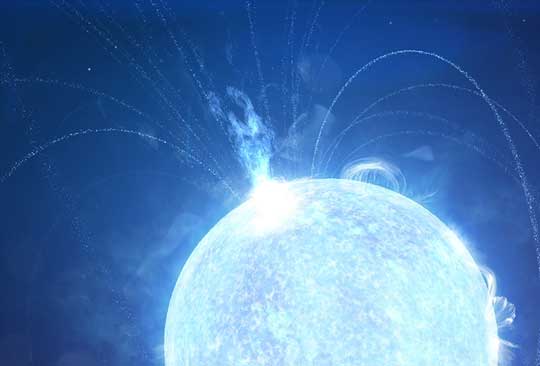In a recent study published in Nature Astronomy, an international team of researchers led by NASA and The George Washington University examined data from an October 2020 detection of what’s known as a “large spin-down glitch event”, also known as an “anti-glitch”, from a type of neutron star known as a magnetar called SGR 1935+2154 and located approximately 30,000 light-years from Earth, with SGR standing for soft gamma repeaters. Such events occur when the magnetar experiences a sudden decrease in its rotation rate, which in this case was followed by three types of radio bursts known as extragalactic fast radio bursts (FRBs) and then pulsed radio emissions for one month straight after the initial rotation rate decrease.
For the study, the researchers examined the magnetar’s rotation using X-ray data from the European Space Agency’s (ESA) X-ray Multi-Mirror Mission (XMM-Newton) currently in Earth orbit, and NASA’s Neutron Star Interior Composition Explorer (NICER) currently attached to the International Space Station (ISS). The researchers demonstrated the sudden reduction in the magnetar’s rotation was likely the result of a volcano-like rupture on the star’s surface that discharged an immense “wind” of particles into space. The study found how such an immense wind could cause variations in the star’s magnetic fields, which then changed to radio emissions that were later detected by China’s Five-hundred-meter Aperture Spherical Telescope (FAST).
“People have speculated that neutron stars could have the equivalent of volcanoes on their surface,” Dr. Matthew Baring, who is a professor of physics and astronomy at Rice University, and a co-author on the study, said in a statement. “Our findings suggest that could be the case and that on this occasion, the rupture was most likely at or near the star’s magnetic pole.”
What makes anti-glitch events so unique is their rare occurrence, with this anti-glitch only being the third such event detected in history. The purpose of this study was to help determine the processes behind anti-glitch events, while glitch events, or the sudden increase in a star’s rotation, can traditionally be explained by changes in the star’s interior. For this paper, a volcano-driven wind model was used to help explain the October 2020 anti-glitch.
“A strong, massive particle wind emanating from the star for a few hours could establish the conditions for the drop in rotational period,” Dr. Baring said. “Our calculations showed such a wind would also have the power to change the geometry of the magnetic field outside the neutron star.”
Dr. Baring said the rupture could be a volcano-like formation since “the general properties of the X-ray pulsation likely require the wind to be launched from a localized region on the surface.”
“What makes the October 2020 event unique is that there was a fast radio burst from the magnetar just a few days after the anti-glitch, as well as a switch-on of pulsed, ephemeral radio emission shortly thereafter,” Dr. Baring said. “We’ve seen only a handful of transient pulsed radio magnetars, and this is the first time we’ve seen a radio switch-on of a magnetar almost contemporaneous with an anti-glitch.”
This is not the first time SGR 1935+2154 has made the news, as NASA’s Neil Gehrels Swift Observatory detected rapid-fire X-ray bursts from this magnetar in April 2020, which was noted as the first FRB detected within the Milky Way Galaxy.
History of Magnetar Observations
Magnetars are a type of neutron star which forms after a star collapses post-supernova. They are known for their extremely powerful magnetic fields that can emit large bursts of high-energy electromagnetic radiation, specifically gamma rays and X-rays. Like most neutron stars, magnetars are small with a diameter of only 20 km (12 mi) and approximately 1.4 solar masses.
While the magnetar anti-glitch event described in this recent study was only the third such event detected in history, magnetars, and more specifically SGRs, are not new to the science world. The first-observed SGR megaflare was detected in March 1979 when a wave of gamma radiation traveling at the speed of light traversed our solar system. During this encounter, several uncrewed NASA, Soviet, and Department of Defense satellites at various locations throughout the solar system were each struck by intense levels of radiation at varying times, which was later used to calculate the source of the immense burst to the supernova remnant SGR 0525-66 within the Large Magellanic Cloud, approximately 165,000 light-years from Earth.
In May 2008, a magnetar subbed SGR 1900+14 was imaged in infrared by NASA’s Spitzer Space Telescope in incredible detail, showing a seven-light-year diameter ring encompassing the massive structure. Scientists postulated in a paper published in Nature at the time that the image of SGR 1900+14 was produced by a giant flare emitted in August 1998.

Magnetars have already taught us about what happens when stars die and the types of radiation they emit, but there’s still a lot more we can still learn about them, and they will continue to be one of the most fascinating objects in the cosmos. What new insights will we learn about magnetars in the coming years and decades? Only time will tell, and this is why we science!
As always, keep doing science & keep looking up!

